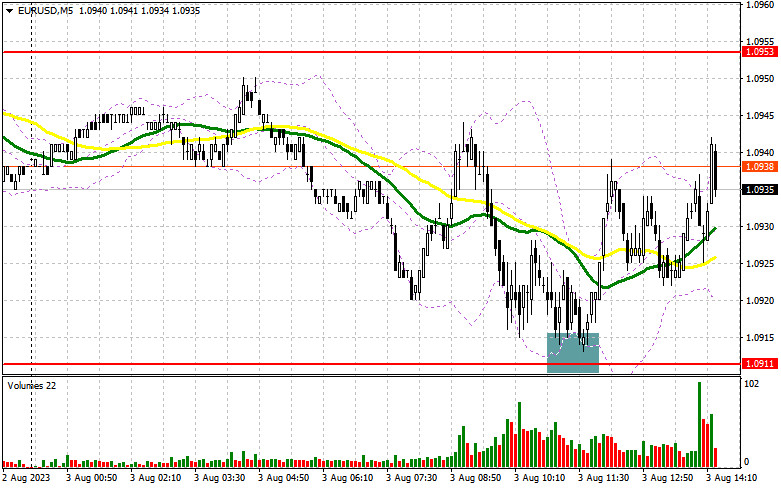
In my morning forecast, I pointed out the significance of the 1.0911 level and advised traders to consider it for entry decisions. Let's review the 5-minute chart and analyze the recent price action. The drop and the subsequent false break at 1.0911 provided a signal for buying, leading to a 20-point upward movement for the EUR/USD pair. From a technical standpoint, there have been no significant changes.

For long positions on EUR/USD, the following conditions must be met:
Revised downward data on economic activity in the Eurozone for July put pressure on the pair, but the bulls quickly absorbed the downward movement, asserting their presence near 1.0911. During the second half of the day, the focus will be on the report on initial jobless claims and the ISM Non-Manufacturing PMI in the USA. If the index rises, it will likely cause EUR/USD to decline again and test the support at 1.0911.
A buying signal can only be generated after a false break occurs at this level. As I previously explained, it may indicate an upward movement with a target of retesting resistance at 1.0953. A successful breakthrough and a subsequent test of this range, especially amid weak PMI data from the USA, will likely increase demand for the euro, potentially leading to a return to the peak at 1.0994. However, expecting further gains beyond that level might not be wise. The ultimate target remains around 1.1043, where I would take profit. In case of a decline in EUR/USD and the absence of significant activity at 1.0911 during the second half of the day (given that this level has already been partially tested), euro buyers could face challenges. In such a scenario, a buying signal for the euro would only emerge after a false break occurs around the next support at 1.0871. I would open long positions only if the pair rebounds from the minimum at 1.0836, aiming for an intraday correction of 30-35 points.
For short positions on EUR/USD, the following conditions must be met:
Sellers still have an opportunity to maintain a bearish market as long as trading remains below the 1.0953 mark. This level is critical and aligns with the moving averages' position, which supports the bearish outlook. If EUR/USD rises after the release of the ISM report, I plan to initiate short positions only after a false break occurs around 1.0953. This sequence of events likely leads to another decline towards 1.0911. A genuine breakthrough and consolidation below this range, along with a retest from below, would signal a selling opportunity and could pave the way toward 1.0871, confirming the establishment of a bearish trend. The ultimate target would be the area around 1.0836, where I would take profit. If EUR/USD experiences an upward movement during the US session and sellers fail to show up at 1.0953 (a possibility), the bulls will attempt to demonstrate their presence. In such a scenario, I would delay short positions until the next resistance at 1.0994. There might also be selling opportunities at that level, but only after a failed consolidation. My entry for short positions would be on a rebound from the peak at 1.1043, targeting a 30-35 point downward correction.
Indicator signals:
Moving averages.
Trading is taking place below the 30-day and 50-day moving averages, indicating a likelihood of further decline for the euro.
Note: The author considers the periods and prices of the moving averages on the hourly chart (H1), which differs from the general definition of classical daily moving averages on the daily chart (D1).
Bollinger Bands:
In the case of an upward movement, the upper boundary of the indicator around 1.0953 will act as resistance.
Description of Indicators:
• Moving Average (determines the current trend by smoothing volatility and noise). Period 50. Marked in yellow on the chart.
• Moving Average (determines the current trend by smoothing volatility and noise). Period 30. Marked in green on the chart.
• MACD Indicator (Moving Average Convergence/Divergence) - Fast EMA period 12. Slow EMA period 26. SMA period 9.
• Bollinger Bands (indicates price volatility and relative price levels). Period 20.
• Non-commercial traders - speculators, such as individual traders, hedge funds, and large institutions, using the futures market for speculative purposes and meeting certain requirements.
• Non-commercial long positions represent the total long open positions of non-commercial traders.
• Non-commercial short positions represent the total short open positions of non-commercial traders.
• The overall non-commercial net position is the difference between non-commercial traders' short and long positions.